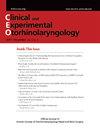螺纹鼻成形术并发症的表现方式及手术处理
IF 2.9
3区 医学
Q1 OTORHINOLARYNGOLOGY
引用次数: 2
摘要
目的近年来,使用丝线的非手术鼻整形术越来越受欢迎。虽然已经强调了这种手术的好处,但可能的并发症及其管理尚不清楚。本研究旨在介绍线鼻成形术并发症的手术处理和结果。方法回顾性分析2018年1月至2021年5月因线鼻成形术并发症而接受翻修鼻成形术的7例患者的病历。对并发症的表现、详细的手术程序和翻修鼻成形术的结果进行了回顾。结果最常见的并发症是尖端可见或挤出的丝线,其次是背部不规则。所有的线都没有被吸收,形状完整,甚至在插入几年后也是如此。线的去除需要仔细的组织解剖,导致失去尖端支撑和背部不规则。为了恢复尖端支撑和伪装背部形状,需要自体组织移植。结论尖端和背侧螺纹的去除伴有结构弱化和部分组织损失,需要进行尖端支撑修复和背侧伪装。本文章由计算机程序翻译,如有差异,请以英文原文为准。
Presentation Patterns and Surgical Management of the Complications of Thread Rhinoplasty
Objectives Nonsurgical rhinoplasty using threads has gained popularity in recent years. While the benefits of this procedure have been emphasized, possible complications and their management are not well-known. This study aimed to present the surgical management and results of the complications of thread rhinoplasty. Methods We retrospectively reviewed the medical records of seven patients who underwent revision rhinoplasty due to the complications of thread rhinoplasty from January 2018 to May 2021. The presentation of complications, detailed surgical procedures, and outcomes of revision rhinoplasty were reviewed. Results Visible or extruded threads at the tip were the most common complication, followed by dorsum irregularity. All the threads were unabsorbed and intact in shape, even several years after insertion. Thread removal necessitated careful tissue dissection, resulting in the loss of tip support and dorsal irregularity. To restore the tip support and camouflage the dorsum shape, an autologous tissue graft was needed. Conclusion Removal of threads at the tip and dorsum was accompanied by structural weakening and partial tissue loss, which required tip support restoration and dorsum camouflage.
求助全文
通过发布文献求助,成功后即可免费获取论文全文。
去求助
来源期刊
CiteScore
4.90
自引率
6.70%
发文量
49
审稿时长
6-12 weeks
期刊介绍:
Clinical and Experimental Otorhinolaryngology (Clin Exp Otorhinolaryngol, CEO) is an international peer-reviewed journal on recent developments in diagnosis and treatment of otorhinolaryngology-head and neck surgery and dedicated to the advancement of patient care in ear, nose, throat, head, and neck disorders. This journal publishes original articles relating to both clinical and basic researches, reviews, and clinical trials, encompassing the whole topics of otorhinolaryngology-head and neck surgery.
CEO was first issued in 2008 and this journal is published in English four times (the last day of February, May, August, and November) per year by the Korean Society of Otorhinolaryngology-Head and Neck Surgery. The Journal aims at publishing evidence-based, scientifically written articles from different disciplines of otorhinolaryngology field.
The readership contains clinical/basic research into current practice in otorhinolaryngology, audiology, speech pathology, head and neck oncology, plastic and reconstructive surgery. The readers are otolaryngologists, head and neck surgeons and oncologists, audiologists, and speech pathologists.

 求助内容:
求助内容: 应助结果提醒方式:
应助结果提醒方式:


